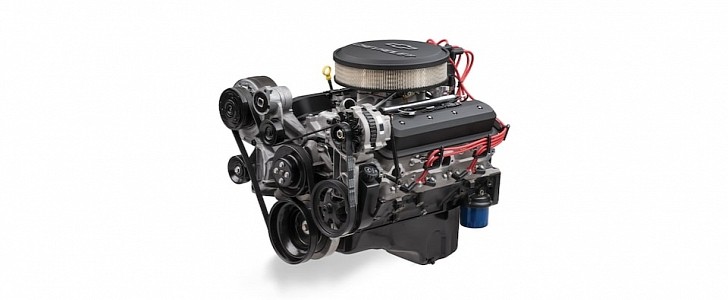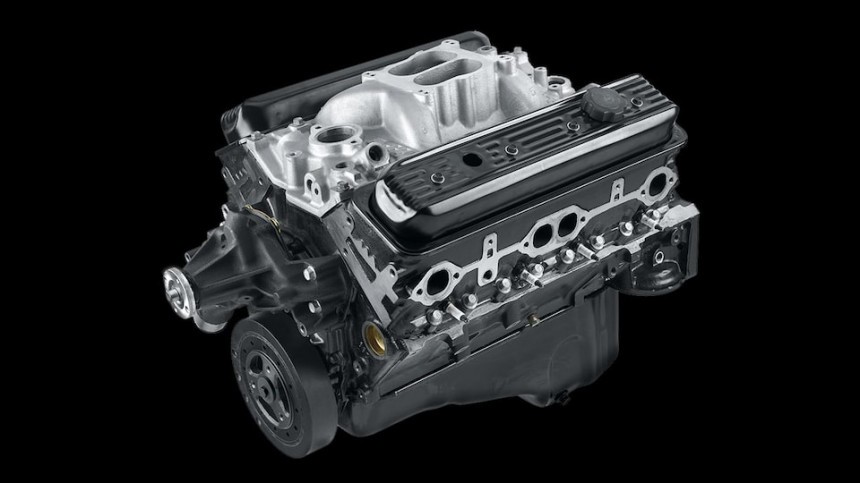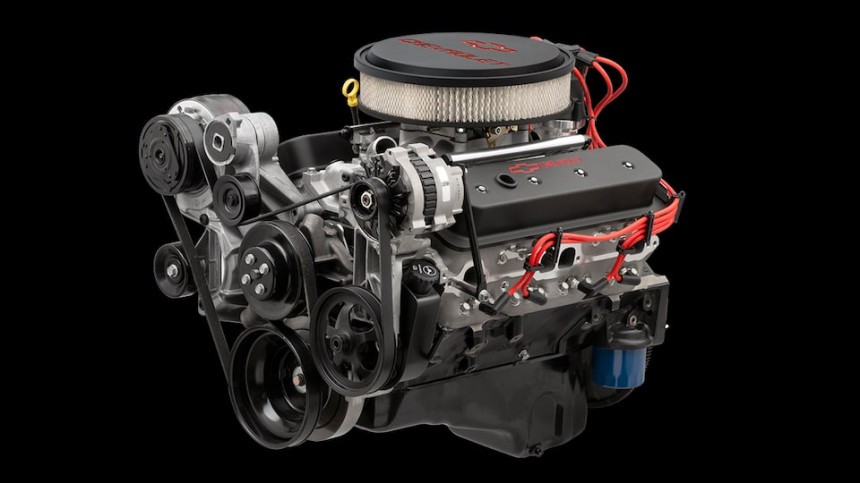The be-all-end-all pushrod V8, the Chevrolet small block is the second V8 engine developed by the Golden Bowtie after the Series D of 1917. The original was discontinued in 1918 because it made similar power to a four-cylinder lump with less displacement. A few decades later, Ed Cole and his team resurrected Chevrolet’s interest in eight-cylinder mills.
Before going over the small-block crate engines that are currently listed on Chevrolet’s website, we should remind ourselves how the son of a dairy farmer decided to develop this engine family. After supervising the design of a cam-in-block V8 at Cadillac, the guy behind the most iconic small block of them all was anointed chief engineer of the Golden Bowtie in 1952. Chevrolet was already developing a V8 powerplant when he arrived, and Edward Nicholas Cole hated it because it was too bulky and complicated.
He instructed his talented group of engineers to work on a brand-new V8 in parallel, demanding it be compact, relatively light, and powerful. It should be noted that many engineers – not just Cole - brought the small block to fruition. Don MacPherson came up with the cross-flow port design of the cylinder, John Dolza developed the green sand casting technique that allowed the block to be cast upside down, Loren Papenguth devised a wafer that metered the flow of oil from the valve lifters through the hollow pushrods, and Clayton Leach is credited for the stamped-steel rocker arms that allowed the series-production V8 to rev like a bonafide racing engine.
Come late 1954, production of the small-block V8 began with the 265, which converts to 4.3 liters if you prefer the metric system. Marketed as the Turbo Fire, this powerplant was popularized by the first-generation Corvette and the second-generation Bel Air. Chevrolet and other divisions continued to improve the Gen 1 for a heck of a long time, but come 1991, the Gen 2 rolled out with the LT1 in the 1992 Chevrolet Corvette. Arguably the most significant improvement over Gen 1 is the reverse-flow cooling system that enabled a higher compression ratio as well as greater spark advance.
The LS we all know and love is the colloquial name given to the third- and fourth-generation small blocks. As for the Gen 5 that General Motors refers to as the LT, its biggest advantage over the fourth-generation small block is direct fuel injection. The only exception to this rule is the LT5 in the C7 ZR1, which introduced GM’s first dual injection system. Although it bears the LT prefix, the LT6 in the C8 Z06 isn’t considered a true small block due to its DOHC valvetrain and flat-plane crank. The LT6 is the only member of the Gemini engine family. Its only technical similarity to the small block as we know it, except for the cylinder count, is the 4.4-inch bore spacing.
Excluding the LT that we’ve already covered and the LS before it, no fewer than 18 small-block crate engines are listed on Chevrolet.com at press time. Clicking on the 350/265 Base and 350/290 Deluxe reveals that both are discontinued, which leaves the HT383 as the entry-level choice with 323 horsepower at 4,200 rpm and 444 pound-foot (602 Nm) at 3,000 revolutions per minute. A high-torque motor with a displacement of 383 cubic inches (6.3 liters), this lump features a cast-iron block with four-bolt main caps, a forged steel crankshaft, hypereutectic aluminum pistons, a hydraulic roller camshaft, a 9.1:1 compression ratio, and stamped-steel rocker arms. Designed for regular-grade dinosaur juice, the HT383 spins to 5,000 rpm.
Its Vortec iron heads are shared with the HT383E, which can be used in 1996 to 1999 full-size trucks and SUVs from General Motors. The HT383 is designed for pre-1980 models. The 350 HO Turn Key levels up to 333 hp at 5,100 rpm, yet torque drops to 381 lb-ft (517 Nm) at 3,700 rpm. Nodular iron is used for the crank, the cam is a hydraulic flat tappet design, the pistons are cast aluminum, and the conrods are powdered-metal steel rather than heavy-duty forged steel. Chevrolet recommends premium gasoline for this 350-based stroker mill whose maximum engine speed is 5,100 rpm.
Next up, the Ram Jet 350 is also discontinued, which brings us to the SP350/357 Base. The street-performance engine delivers 357 hp at 5,500 rpm and 407 lb-ft (552 Nm) at 4,000 rpm on premium fuel, topping at 5,600 rpm. The SP350/357 Deluxe and SP350/357 Turn Key are listed as well, and the fine print obviously reads competition or off-highway use only.
As for the ultimate incarnation of the SP350, that would be the 385 in either Base or Turn-Key flavors. The SP350/385 incorporates beehive-type valve springs and high-flow aluminum cylinder heads for low-rpm torque and high-rpm performance. Good for 385 hp at 5,600 rpm and 405 lb-ft (549 Nm) at 3,600 rpm, this extremely versatile V8 rocks a 9.6:1 compression ratio, shot-peened forged steel for the crankshaft, and spins to 5,800 rpm.
The ZZ6 blends classic style with modern drivability. Displacing 350 cubes (5.7 liters), this fellow is available in two versions: carbureted or fuel injected. The ZZ6 Base is curiously listed with 404 hp at 5,600 rpm on the small-block crate engine page and 405 hp on the product page. Its Turn-Key alternative features the same ponies and 406 lb-ft (550 Nm) at 4,600 rpm.
As for the EFI Deluxe and EFI Turn Key, these bad boys boast 420 hp at 5,800 rpm and 408 lb-ft (553 Nm) at 4,500 rpm. The electronically-controlled port fuel injection system is complemented by an aluminum intake manifold and an air cleaner that hides the throttle body from prying eyes. The Deluxe package includes the distributor, damper, and flexplate, whereas the Turn Key adds the starter, fuel pump, alternator, air conditioning pump, and FEAD kit.
Simply put, the SP383 crate engine is a ZZ6 with a few more cubic inches of displacement. Customers in the market for the Deluxe should look forward to 435 hp at 5,600 rpm and 445 lb-ft (603 Nm) at 4,600 rpm. The EFI Deluxe and EFI Turn Key improve to 450 horsepower at 5,800 rpm at the expense of torque, which goes down to 436 pound-foot (591 Nm) at 4,800 rpm.
The Deluxe runs a 9.6:1 compression ratio, whereas the fuel-injected EFI Deluxe and EFI Turn Key improve to 9.72:1. Similar to the SP350/385 and up, the SP383 uses Fast Burn-style aluminum cylinder heads with 62-cc chambers. From the HT383 to the SP383, all these small-block V8 crate engines come with a 24-month/50,000-mile (80,000-kilometer) warranty.
He instructed his talented group of engineers to work on a brand-new V8 in parallel, demanding it be compact, relatively light, and powerful. It should be noted that many engineers – not just Cole - brought the small block to fruition. Don MacPherson came up with the cross-flow port design of the cylinder, John Dolza developed the green sand casting technique that allowed the block to be cast upside down, Loren Papenguth devised a wafer that metered the flow of oil from the valve lifters through the hollow pushrods, and Clayton Leach is credited for the stamped-steel rocker arms that allowed the series-production V8 to rev like a bonafide racing engine.
Come late 1954, production of the small-block V8 began with the 265, which converts to 4.3 liters if you prefer the metric system. Marketed as the Turbo Fire, this powerplant was popularized by the first-generation Corvette and the second-generation Bel Air. Chevrolet and other divisions continued to improve the Gen 1 for a heck of a long time, but come 1991, the Gen 2 rolled out with the LT1 in the 1992 Chevrolet Corvette. Arguably the most significant improvement over Gen 1 is the reverse-flow cooling system that enabled a higher compression ratio as well as greater spark advance.
The LS we all know and love is the colloquial name given to the third- and fourth-generation small blocks. As for the Gen 5 that General Motors refers to as the LT, its biggest advantage over the fourth-generation small block is direct fuel injection. The only exception to this rule is the LT5 in the C7 ZR1, which introduced GM’s first dual injection system. Although it bears the LT prefix, the LT6 in the C8 Z06 isn’t considered a true small block due to its DOHC valvetrain and flat-plane crank. The LT6 is the only member of the Gemini engine family. Its only technical similarity to the small block as we know it, except for the cylinder count, is the 4.4-inch bore spacing.
Its Vortec iron heads are shared with the HT383E, which can be used in 1996 to 1999 full-size trucks and SUVs from General Motors. The HT383 is designed for pre-1980 models. The 350 HO Turn Key levels up to 333 hp at 5,100 rpm, yet torque drops to 381 lb-ft (517 Nm) at 3,700 rpm. Nodular iron is used for the crank, the cam is a hydraulic flat tappet design, the pistons are cast aluminum, and the conrods are powdered-metal steel rather than heavy-duty forged steel. Chevrolet recommends premium gasoline for this 350-based stroker mill whose maximum engine speed is 5,100 rpm.
Next up, the Ram Jet 350 is also discontinued, which brings us to the SP350/357 Base. The street-performance engine delivers 357 hp at 5,500 rpm and 407 lb-ft (552 Nm) at 4,000 rpm on premium fuel, topping at 5,600 rpm. The SP350/357 Deluxe and SP350/357 Turn Key are listed as well, and the fine print obviously reads competition or off-highway use only.
As for the ultimate incarnation of the SP350, that would be the 385 in either Base or Turn-Key flavors. The SP350/385 incorporates beehive-type valve springs and high-flow aluminum cylinder heads for low-rpm torque and high-rpm performance. Good for 385 hp at 5,600 rpm and 405 lb-ft (549 Nm) at 3,600 rpm, this extremely versatile V8 rocks a 9.6:1 compression ratio, shot-peened forged steel for the crankshaft, and spins to 5,800 rpm.
As for the EFI Deluxe and EFI Turn Key, these bad boys boast 420 hp at 5,800 rpm and 408 lb-ft (553 Nm) at 4,500 rpm. The electronically-controlled port fuel injection system is complemented by an aluminum intake manifold and an air cleaner that hides the throttle body from prying eyes. The Deluxe package includes the distributor, damper, and flexplate, whereas the Turn Key adds the starter, fuel pump, alternator, air conditioning pump, and FEAD kit.
Simply put, the SP383 crate engine is a ZZ6 with a few more cubic inches of displacement. Customers in the market for the Deluxe should look forward to 435 hp at 5,600 rpm and 445 lb-ft (603 Nm) at 4,600 rpm. The EFI Deluxe and EFI Turn Key improve to 450 horsepower at 5,800 rpm at the expense of torque, which goes down to 436 pound-foot (591 Nm) at 4,800 rpm.
The Deluxe runs a 9.6:1 compression ratio, whereas the fuel-injected EFI Deluxe and EFI Turn Key improve to 9.72:1. Similar to the SP350/385 and up, the SP383 uses Fast Burn-style aluminum cylinder heads with 62-cc chambers. From the HT383 to the SP383, all these small-block V8 crate engines come with a 24-month/50,000-mile (80,000-kilometer) warranty.





























